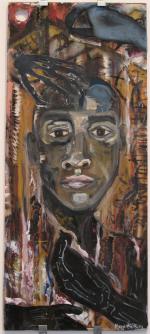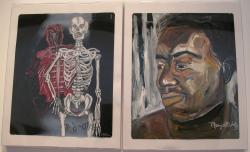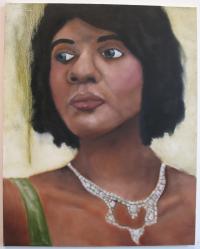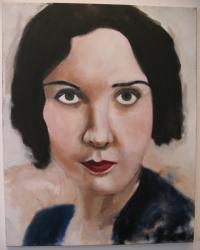 There
is always some experience that acts as starting point inspiring an
artist to begin a work. It could be the light on a surface, a
gathering of forms, or the mood of a face. It might be the work of
another artist, or a memory. There are thousands of sources. The best
beginnings are those that, when filtered through the artist, turn the
eye inward, causing discovery in and communication with the viewer.
There
is always some experience that acts as starting point inspiring an
artist to begin a work. It could be the light on a surface, a
gathering of forms, or the mood of a face. It might be the work of
another artist, or a memory. There are thousands of sources. The best
beginnings are those that, when filtered through the artist, turn the
eye inward, causing discovery in and communication with the viewer.
In the pleasing space and light of the Catich Gallery in St. Ambrose University's Galvin Fine Arts Center, Holly Hunt and Margret O'Reilly (both senior art students) present us an exhibition of portraits based on filtered memory and examined life experiences. (The show ends May 5.) One artist began her work from the memory of a particular woman, and the other from a collage of her recent experiences as an art therapist with juvenile boys. Both paint in series and both have the similar goal of sparking reflection in the audience.
O'Reilly said she became interested in human development and psychology while working in an eight-week art-therapy internship in a group home for boys in inner-city Chicago. This experience, coupled with the task of cleaning out her father's storeroom of old 16-by-20-inch X-rays, gave her the inspiration to paint her former students on the surface of the smooth X-ray film.
What came out were composite oil paintings of the adolescent boys, paired with lifelike medical illustrations of physical systems of the body. She went on to associate these diptychs - the portrait and the medical systems - with Erik Erikson's theories of the eight stages of human development: hope, will, purpose, competence, fidelity, love, care, and wisdom.
These ideas, although valuable for our own understanding of human growth, are a secondary consideration in the show and understood only obliquely from the paintings.
Her portraits are strongly painted, on the thin line between distortion and reality, with expressionistic colors and energetic brushwork. The faces are described, but loosely. They seem to materialize as we look, becoming recognizable through bright accents of color and definite lines. Gradually the portraits progress, across the wall, toward descriptive contour lines on dark backgrounds, a few Matisse brush strokes to describe a head.
 Coupled
with the portraits are realistic and well-painted images of eight
human-body systems: lungs, intestines, womb, veins and arteries, a
cross-section of the skin, cranium, skeleton, and nervous system. Her
combination of these two subjects - the portraits and the medical
illustrations - could have made two exhibits: one based on color
and expression, and the other on her excellent drawing skills. The
combination doesn't quite harmonize, beyond understanding that we
are all the same underneath.
Coupled
with the portraits are realistic and well-painted images of eight
human-body systems: lungs, intestines, womb, veins and arteries, a
cross-section of the skin, cranium, skeleton, and nervous system. Her
combination of these two subjects - the portraits and the medical
illustrations - could have made two exhibits: one based on color
and expression, and the other on her excellent drawing skills. The
combination doesn't quite harmonize, beyond understanding that we
are all the same underneath.
In the final, single piece at the right, she has painted a tall, thin portrait of her favorite youth from the internship. His is the only likeness that is not a composite and not associated with a body system. His combines her two realms into her best work, well-drawn. Perhaps their emotional bond created a stronger piece. He looks at us straight on with an intelligent face. The negative space is covered in dark energetic colors. Over his shoulder lurks an X-ray cutout of a hand's skeletal structure, bony fingers from his past reaching out to maintain a grip. But he holds a bird form in his hands, like a dove - the sign of hope.
When I asked her about this form, she said it was actually an X-ray of the muscles of a hand, balancing the work. She was surprised to see that she had cut out and placed a bird form in her painting. As often happens in good art, during the thinking and making, the painting can offer hints of something more, unimagined, something that can transform into a meaning beyond the artist's original intentions.
 Inspired
by the memory of her admired great-aunt Esther, Holly Hunt combed
through antique photographs to find images of women from her era, the
American 1920s.
Inspired
by the memory of her admired great-aunt Esther, Holly Hunt combed
through antique photographs to find images of women from her era, the
American 1920s.
Using black-and-white photographs as her reference points, she created oil-painted portraits with bright and imagined colors and 11 archetypal personalities: pilot, ballerina, mother, artist, feminist, jazz singer, poet, synchronized swimmer, actress, anthropologist, and pianist. They all look famous, although most of them are nameless.
Each face has strong features with a good likeness, softly painted, often with drips of thin paint near the edges. None has background context, so there is no distraction of association with any particular place. All are painted with closed mouths, some with glamorous red lipstick fitting the fashion of the time. Many eyes have a melancholy appearance, as if the women have been buffeted by experience.
Most of the forms are painted in light thin washes of color. There are few lines in the portraits except near the eyes, which are effectively painted but require another pass. The noses seem to have been painted on a different perspective from the rest of the body. But these are minor points, for the total effect is charming.
These are more than simple portraits; as with any art, the paintings become vehicles for exploration and self-discovery for the artist. Each imagined personality forms a relationship with the artist through the artist's own qualities of empathy and experience. Later on, they form relationship with the audience. They quickly and quietly enter our consciousness.
I can understand how making portraits can pull in both the artist and an audience. Portraits can reflect the different sides of an artist's nature, or act as a personality that can be entered into, like an actor playing a character. Hunt identifies with each portrait, she said, from her own experiences with people. "Each is a part of me," said the artist.
Hunt's goal, she said, is for the viewers to interpret each woman's thoughts, moods, and personalities, and relate them to the audience's own, prompting either identification or reflection.
The Jazz Singer, or Bessie Smith, looks out to us with an honest and pure heart. We can tell by her expression and the depth of her gaze.
Another, Ballerina, seems proud of her life, distancing us all and protecting herself. We can sense that in her eyes.
 A
wise black woman, The Poet, with glasses and green eyes, looks
like a schoolteacher who didn't put up with any talking. The artist
said she hesitated for these pictures to leave her studio for the
show, like saying goodbye to close friends for a while. I imagine a
conversation among them when the gallery is closed at night.
A
wise black woman, The Poet, with glasses and green eyes, looks
like a schoolteacher who didn't put up with any talking. The artist
said she hesitated for these pictures to leave her studio for the
show, like saying goodbye to close friends for a while. I imagine a
conversation among them when the gallery is closed at night.
Looking back on any artist's arc of work over the years, we can often see essential patterns and interests that have developed from the beginning, often reoccurring. Seeing these two good and sympathetic young artists now, at the beginning of their artistic careers, one cannot know the curve their work will take into the future.
But certain patterns have already been established. They both share an interest in personal self-discovery and humanity. Both have achieved the inner eye, which sees beyond the surface. Both are interested in nudging the audience toward introspection. And both are looking for insights into human behavior that they can apply to themselves. Where their paths lead can only be good.










